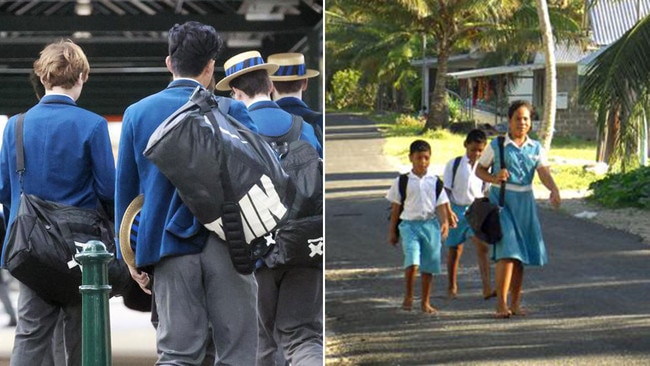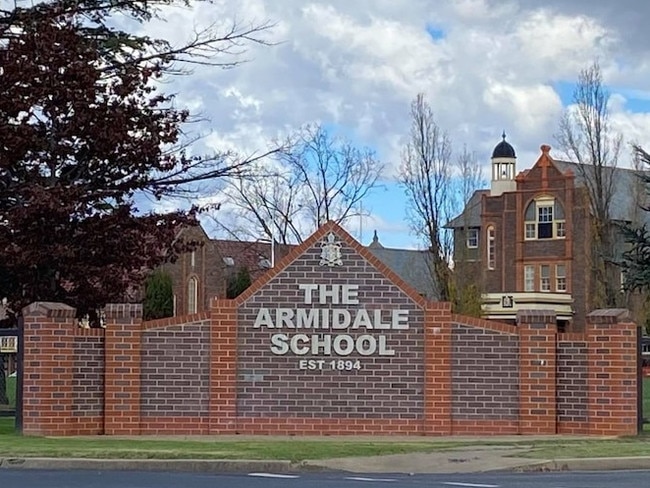Richest and Poorest NSW schools for 2023 revealed
Some of NSW’s most prestigious schools raked in more cash in 2023 than some of Australia’s neighbouring island nations. Search our list to see which schools are cashed up and which have been left behind.

Schools Hub
Don't miss out on the headlines from Schools Hub. Followed categories will be added to My News.
The richest school in NSW has banked more money in fees, funding and gifts from wealthy donors over the last five years than the total annual economic output of five of Australia’s Pacific island neighbours, financial figures for every school in the state reveal.
The revelation comes as new data re-energises the debate over private and public school funding, with experts saying chronic underfunding risks some schools not being able to give students a “fair go”.
Knox Grammar School in Sydney’s Upper North Shore brought in $536,440,456 across five years, and increased their revenue by 14.20 per cent from 2017 to 2021.
The enormous sum surpasses the GDP of five Pacific island countries in 2021; Tuvalu (USD$63.10m), Nauru (USD$133.22m), Kiribati (USD$207.03m), Palau (USD$217.80m) and the Marshall Islands (USD$259.54m).
So extreme is the contrast in wealth, Knox’s 2021 income of $112.75 million eclipsed Tuvalu’s GDP in one year alone.
On a per capita basis, each Knox student attracts $35,500 – five times as much wealth as one Tuvaluan.

In 2021, the school received a total $12,101,144 in public money.
Non-government schools account for the 56 richest in the state.
The top 10 alone have brought in nearly $4 billion in five years – more than the bottom 685 schools combined.
Cherrybrook Technology High School, a comprehensive secondary school in Sydney’s northwest, is the highest-earning public school over the five year period, amassing $131,029,343 after gleaning nearly $3 million from parents and private sources in 2017 alone.
BUSH KIDS COP BIGGEST GAPS
In the bush, the divide is stark. The poorest school in the state, Breadalbane Public School, is a tiny regional school just outside Goulburn with only seven students and $310,653 to its name – however, it has one of the highest per capita funding amounts ($44,379 per student) due to its size and remoteness.
In Armidale, two of the state’s richest and poorest schools share a street. The Armidale School (TAS), is one of nine GPS schools and the only one outside of metropolitan Sydney. It is the 143rd richest school in the state, with a five year income of $913.7 million, and ranks 312th in NAPLAN primary results.
Behind TAS on Chapel Street, Newling Public School ranks 1848th, but is the 2243rd richest school.

Armidale Teachers Association president Michael Sciffer said the two schools provide “probably the most stark example” of public and private segregation in the area.
“ (Newling) has a high Indigenous enrolment. The teachers do an amazing job there. I’ve done a little bit of work there as a school counsellor … they got great stuff going on,” he said.
“But (the difference) is just really stark when you look across the road at this GPS school, which proudly flies an Aboriginal flag, and has an Aboriginal enrolment of five per cent.
“I keep finding new bits of land that they own around town. They’ve got their own indoor shooting range. I thought it was the town gun club but it actually belongs to TAS.”
INEQUITY ‘BAKED IN’
Gonski Institute deputy director Scott Eacott said while increases in funding alone won’t necessarily improve student outcomes, underfunding some schools while over-funding others makes it “next to impossible” for school to deliver on the results expected.
“Funding based on equality rather than equity bakes in inequities in the school system,” Professor Eacott said.
“Data shows that public schools do the heavy lifting when it comes to students requiring additional supports. The enduring underfunding of government schools … simply makes it difficult for public schools to provide the opportunities necessary to meet the ‘fair go’ and ‘Lucky Country’ claims we so often like to make about Australia.”
The 47 highest income schools on a per-student basis are all public schools, the vast majority having fewer than 50 students and some as few as four. Those that aren’t based in regional and remote communities cater to specific needs, such as intensive English language schools, owing to a needs-based model which provides more funding based on the language, disability and Aboriginal and Torres Strait Islander status of students.
WHAT’S IN A NAME? TALE OF TWO NEWINGTONS
In NSW there are 123 public schools which fell short of the $12,099 “base funding” amount set by the federal government for primary students in 2021, predominantly in more affluent suburbs. One of those schools is Newington Public School, where the Casali family have enrolled eight-year-old Mia and her brother, five-year-old Lachy.
Newington PS students received $11,931 each from all sources, a figure security manager dad Chris Casali found “quite surprising”.
However, despite the school slotting in the top quarter of public schools overall with $46.4 million over five years, families do have their frustrations he said.
“When you’re out there during summer – especially considering how hot it does get around here – you need basic things like airconditioning in the school hall,” Mr Casali said.
“There’s not a lot of shade either – it’s just simple things like that (we need).”
Comparatively, namesake GPS founding member school Newington College attracted more than seven times the public school’s figure in total income, and is the eighth richest school in the state.
“I don’t think it’s fair how a lot of the private schools can dip into public funds when exorbitant school fees are being paid,” Mr Casali said.
“Isn’t that the point of it, (parents) pay the fees to get these good services, not the taxpayer? To me it feels a bit like double-dipping.”
Data has been curated to feature schools that have taken the most gross revenue over a five-year period.





